
M60 machine gun
Encyclopedia
The M60 is a family of American
general-purpose machine guns firing 7.62×51mm NATO
cartridges
from a disintegrating belt
of M13 link
s. There are several types of live ammunition approved for use in the M60, including ball
, tracer
, and armor-piercing
rounds.
Introduced in 1957, it has served with every branch of the U.S. military
and still serves with other armed forces. Its manufacture and continued upgrade for military and commercial purchase continues into the 21st century, though it has been replaced or supplemented in most roles by other designs, notably the M240
in U.S. service.
and operated by a team of two or three individuals. The team consists of the gunner, the assistant gunner (AG in military slang), and the ammunition bearer. The gun's weight and the amount of ammunition it consumes when fired make it difficult for a single soldier to carry and operate. The gunner carries the weapon and, depending on his strength and stamina, anywhere from 200 to 1000 rounds of ammunition. The assistant carries a spare barrel
and extra ammunition
, and reloads and spots targets for the gunner. The ammunition bearer carries additional ammunition and the tripod with associated traversing and elevation mechanism, if issued, and fetches more ammunition as needed during firing.
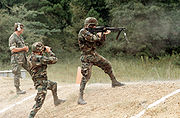 The M60 can be accurately fired at short ranges from the shoulder due to its design. This was an initial requirement for the design and a hold-over in concept from the M1918 Browning Automatic Rifle. It may also be fired from the integral bipod, M122 tripod
The M60 can be accurately fired at short ranges from the shoulder due to its design. This was an initial requirement for the design and a hold-over in concept from the M1918 Browning Automatic Rifle. It may also be fired from the integral bipod, M122 tripod
, and some other mounts.
M60 ammunition comes in a cloth bandolier
containing a cardboard box of 100 pre-linked rounds. The M60 changed from M1 link to the different M13 link, a change from the older link system with which it was not compatible. The cloth bandolier is reinforced to allow it to be hung from the current version of the feed tray. Historically, units in Vietnam used B3A cans from C-ration
s packs locked into the ammunition box attachment system to roll the ammunition belts over for a straighter and smoother feed to the loading port to enhance reliability of feed. The later models changed the ammunition box attachment point and made this adaptation unnecessary.
and to a lesser extent the MG 42), but it contained American innovations as well. Early prototypes, notably the T52 and T161 bore a close resemblance to both the M1941 Johnson machine gun and the FG-42. It was intended to replace the M1918 Browning Automatic Rifle and M1919A6 Browning machine gun
in the squad automatic weapon role, and in the medium machine gun role. One of the weapons tested against it during its procurement process was the FN MAG
.
 The U.S. Army
The U.S. Army
officially adopted the M60 in 1957. It later served in the Vietnam War
as a squad automatic weapon
with many U.S. units. Every soldier in the rifle squad would carry an additional 200 linked rounds of ammunition for the M60, a spare barrel, or both. The up-gunned M113 armored personnel carrier
ACAV added two M60 gunners beside the main .50 caliber machine gun, and the Patrol Boat, River
had one in addition to two .50 cal mounts.
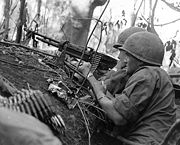 During the Vietnam War
During the Vietnam War
, the M60 received the nickname "The Pig" due to its size.
In the 1980s, the M60 was partially replaced by the M249 Squad Automatic Weapon
within the infantry squad. The M60 was retained in the vehicle mounted role and the general-purpose role due to its greater power and range compared to the 5.56 mm
M249. In United States Marine Corps
service, concerns about the M60's reliability, weight, and the high round counts of many M60s in service prompted the adoption of the M60E4 (or also known as MK43MG) to replace most original M60s in infantry units.
 Starting with Ranger Battalions, the US Army began adopting and modifying M240 variants to replace their remaining M60s in the early 1990s. The M240 is several pounds heavier than the M60, and has a longer barrel and overall length, but is more reliable in use and testing. However, the M60 uses a much simpler gas system that, when care is taken during reassembly, is easier to clean. This advantage is obviated by the fact that the gas tube is wired shut with lockwire to prevent the weapon from disassembling itself due to vibration in hard use.
Starting with Ranger Battalions, the US Army began adopting and modifying M240 variants to replace their remaining M60s in the early 1990s. The M240 is several pounds heavier than the M60, and has a longer barrel and overall length, but is more reliable in use and testing. However, the M60 uses a much simpler gas system that, when care is taken during reassembly, is easier to clean. This advantage is obviated by the fact that the gas tube is wired shut with lockwire to prevent the weapon from disassembling itself due to vibration in hard use.
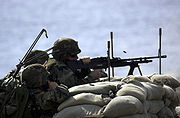 The M60 continues to be used in the 21st century by U.S. Navy SEALs
The M60 continues to be used in the 21st century by U.S. Navy SEALs
and as a door gun on U.S. Army helicopters, and was the main 7.62 mm machine gun by some U.S. special operations forces
to the late 1990s. As of 2005, it is used by the Coast Guard
, Navy, and a some reserve units, though it is being phased out in favor of the M240 7.62 mm medium machine gun. Its use as an Army helicopter door gun will soon taper off, as an improved M240 version has been adopted for this role.
machine gun that fires from the open-bolt position and is chambered for the 7.62 mm NATO cartridge. Ammunition is usually fed into the weapon from a 100-round bandolier
containing a disintegrating, metallic split-link belt.
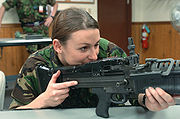 The design drew on many common concepts in firearms manufacture of the period, such as stamped sheet metal construction, belt feed (a modified mechanism for belt feed from the MG42
The design drew on many common concepts in firearms manufacture of the period, such as stamped sheet metal construction, belt feed (a modified mechanism for belt feed from the MG42
with a single pawl), quick barrel replacement, a pistol grip
and stock
, and a Semi bullpup design similar to the FG42 (much of the action occupies the weapon's stock). The M60's operating system of an operating rod turning a rotating bolt was inspired by the FG42, which was based on the much earlier Lewis Gun
. The M60's gas operation is unique, and drew on technical advances of the period, particularly the White "gas expansion and cutoff" principle also exploited by the M14 rifle. The M60's gas system was simpler than other gas systems and easier to clean.
The straight-line layout allowed the operating rod and buffer to run directly back into the buttstock and reduce the overall length of the weapon.
As with all such weapons, it can be fired from the shoulder, hip, or underarm position. However, to achieve the maximum effective range, it is recommended that a bipod-steadied position or a tripod-mounted position be used and fired in bursts of 3–5 rounds. The weapon is heavy and difficult to aim when firing without support, though the weight helps reduce the felt recoil. The large grip also allowed the weapon to be conveniently carried at the hip. The gun can be stripped using a live round of ammunition as a tool. However, this is highly discouraged, as doing so can damage that round and increase the chance of a misfire.
The M60 is often used with its own integrated bipod or with the M122 tripod
. The M60 is considered effective up to 1,100 meters when firing at an area target and mounted on a tripod
; up to 800 meters when firing at an area target using the integral bipod
; up to 600 meters when firing at a point target; and up to 200 meters when firing at a moving point target. United States Marine Corps
doctrine
holds that the M60 and other weapons in its class are capable of suppressive fire
on area targets out to 1,500 meters if the gunner is sufficiently skilled.
Originally an experimental M91 tripod was developed for the M60, but an updated M2 tripod design was selected over it which became the M122. The M122 would be itself replaced in the 2000s by a new mount, in time for the M60 to also be used with it.
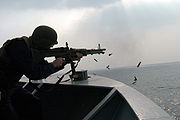
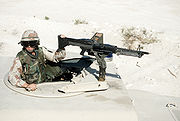 The M60 family of weapons are capable of firing standard NATO rounds of the appropriate caliber. Most common in U.S. use are M61 Armor piercing, M62 Tracer
The M60 family of weapons are capable of firing standard NATO rounds of the appropriate caliber. Most common in U.S. use are M61 Armor piercing, M62 Tracer
, and M80 Ball. For training purposes, M63 Dummy and M82 Blanks
are used. The new tungsten
cored M993 Armor-piercing rounds may also be fired in the M60 as well, though they did not enter the inventory until after the M60 was withdrawn from service in active-duty units.
When firing blanks, the M13 or M13A1 blank-firing adaptor
(BFA) is necessary in order to produce enough gas pressure to cycle the weapon with blanks. All ammunition must be fixed in a NATO standard M13 disintegrating metallic split-link belt to feed into the weapon.
The standard combat ammunition mix for the M60 consists of four ball (M80) cartridges and one tracer (M62) in belts of 100 rounds. The four to one ratio theoretically allows the gunner to accurately "walk" the fire into the enemy. Tracer bullets do not fly quite the same trajectory as ball and weapon's sights must be used for accurate fire—particularly at ranges in excess of 800 meters, where 7.62x51mm NATO tracer bullets usually burn out and are no longer visible. This is a problem for all weapons in this caliber using this tracer round.
 When tested in the field, the M60 was fairly effective, but in the jungles of Southeast Asia
When tested in the field, the M60 was fairly effective, but in the jungles of Southeast Asia
in which it was soon used, the initial versions displayed several potential problems when used on the ground. A common complaint was the weapon's weight, though M60 was among the lightest 7.62 mm machine guns of the era.
For units in Vietnam, the single most common complaint was that the M60 was comparatively unreliable and prone to jamming and other malfunctions, especially when it was dirty. Fine sand and dust in the mechanism could bring the M60 to a halt. This was a major factor in the Israeli Defense Force declining to adopt the M60 in favor for the FN MAG
. The weapon was more difficult to clean and maintain than the M1918A2 Browning Automatic Rifle (BAR) it replaced in the squad. In normal conditions it would often fire thousands of rounds without a serious jam, while field conditions tended to reduce reliability without proper maintenance.
The safety was awkward to operate and worked the "wrong way" for soldiers who were trained with the M16 rifle and M1911A1 pistol—that is, it required an upward movement of the thumb on the safety catch to make the gun ready to fire, rather than a downward movement as with the other weapons. Additionally, it is possible to install parts of the fire control mechanism incorrectly, causing a "runaway gun"—meaning that it would keep firing until empty even if the operator took his finger off the trigger. The gas system of the original model could be assembled incorrectly causing failure to function and could unscrew and come apart if not safety wire
d in place.
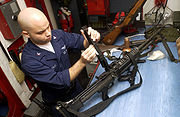 The M60 sometimes (depending on the version) tore rims off of fired cartridge cases during the extraction cycle, resulting in failure to remove the empty case, causing a jam that could take time to clear. The barrel latch mechanism (a swinging lever) could catch on the gunner's equipment and accidentally unlatch, causing the barrel to fall out of the gun. The lever was replaced with a push button mechanism that was less likely to be accidentally released, but many of the swinging-lever latches are still on guns in inventory, forty years after this problem was discovered.
The M60 sometimes (depending on the version) tore rims off of fired cartridge cases during the extraction cycle, resulting in failure to remove the empty case, causing a jam that could take time to clear. The barrel latch mechanism (a swinging lever) could catch on the gunner's equipment and accidentally unlatch, causing the barrel to fall out of the gun. The lever was replaced with a push button mechanism that was less likely to be accidentally released, but many of the swinging-lever latches are still on guns in inventory, forty years after this problem was discovered.
The grip/trigger housing assembly is held in place with a rather fragile leaf spring clip instead of the captive pins used in other designs. The spring clip has been known to be prone to breakage since the first trials at Aberdeen Proving Ground. Duct tape and cable ties have been seen on M60s in the field, placed there by their crews in case the spring clip breaks. The sear
in the trigger mechanism gained a reputation for wearing down and a malfunction could cause the gun to "run away". A second sear notch was eventually added to the operating rod to reduce the chance of this happening.
Several critical parts of early production M60s, such as the receiver
cover and feed tray, were made from very thin sheet metal stampings and prone to bending or breaking; sturdier parts were eventually available in the early 1970s. Early M60s also had driving spring guides and operating rods that were too thin and gas pistons that were too narrow behind the piston head (part of an attempt to save weight), leading to problems with breakage. Metallurgical problems also played a part, (blamed by some on low-bid contractors), but after 1970 a slightly heavier part was designed and slowly put into the supply chain. High-round-count weapons were also susceptible to stretching of the receiver and other parts.
 Another criticism with some versions of the M60 is that the barrel was heavy. The bipod was a permanent fixture to the barrel as well as the gas chamber of the gas system; the latter was a result of using a piston design with a fixed regulator design. The advantage of the fixed regulator was no adjustment was required, though it risked the ability to compensate for fouling of the gas system, leading to insufficient power to operate the action, including lifting the ammunition belt. The non-adjustable front sight is fixed to the barrel, and adjustments for "zeroing" the sights could only be made at the rear sight, requiring readjustment when the barrel is changed—not ideal for combat situations. The bipod being attached to the barrel also meant that the weapon had to be put down on the ground for a barrel change, complicating the process unnecessarily, especially in combat conditions.
Another criticism with some versions of the M60 is that the barrel was heavy. The bipod was a permanent fixture to the barrel as well as the gas chamber of the gas system; the latter was a result of using a piston design with a fixed regulator design. The advantage of the fixed regulator was no adjustment was required, though it risked the ability to compensate for fouling of the gas system, leading to insufficient power to operate the action, including lifting the ammunition belt. The non-adjustable front sight is fixed to the barrel, and adjustments for "zeroing" the sights could only be made at the rear sight, requiring readjustment when the barrel is changed—not ideal for combat situations. The bipod being attached to the barrel also meant that the weapon had to be put down on the ground for a barrel change, complicating the process unnecessarily, especially in combat conditions.
There was no handle to hold the barrel by for changes. A large asbestos
glove was part of the standard issue to allow the crew to handle hot barrels during barrel change. Loss of the glove was always a problem.
U.S. Marines especially disliked the M60, and many Marine units held onto their BARs
until 1967–68 officially, and longer unofficially. The M60E3 variant designed in the mid-1980s for the U.S. Marine Corps, reduced the design's weight to 18.9 lb (8.61 kg) unloaded and slightly improved reliability. Users complained about the quickly overheating barrel, a common problem with the original M60. This problem was aggravated in the M60E3, which uses a lighter barrel, which required changing every 100 rounds instead of every 200. The M60E3's barrel used a wire-and-plastic handle near the breech end and could be changed safely without the use of heat-resistant mittens.
The U.S. Navy special operations forces continued to use the M60E3 for years because of its portability and low weight for its caliber, with a number of upgrades, including a change in feed system and barrel configuration. Additional required changes were the addition of rails for optical sights and other modern accessories.
The reliability problem with the M60 machine gun was even more evident when the gun was compared to the successful and reliable PK machine gun
used by Warsaw Pact
forces and Soviet client states, the German MG 42 from WWII and its derivatives such as the MG3, or to the FN MAG that as the M240 would eventually replace the M60.
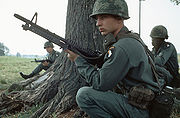 The nomenclature M60 describes either the first adopted version or, generically, the family of weapons derived from it.
The nomenclature M60 describes either the first adopted version or, generically, the family of weapons derived from it.
Major variations include the M60E1 (an improved version that did not enter production), the M60E2 (a version designed to be used from fixed mounts as a co-axial for armored vehicles or in helicopter armament systems), the M60E3 (a lightweight version) and the M60E4 (another improved version, designated Mk 43 Mod 0 by the U.S. Navy
).
The M60C was adopted for use on fixed mounts on aircraft. It was characterized by the use of an electric solenoid to operate the trigger and a hydraulic system to charge the weapon. The M60D differed from the base model by employing spade grips, a different sighting system, and lacking a forearm. It was typically employed as a door gun on helicopters or as a pintle mounted weapon as on the Type 88 K1
tank.
There are many smaller variants among each type, between makers of the firearm, and over time.
 The initial version was officially adopted by the U.S. Army in the late 1950s, though at this time it was only intended for the infantry. It was known as the T161 before it was adopted (specifically the T161E3), and was chosen over the competing T52 during testing in the 1950s. They both used a similar feed and were both gas-operated, but the T161 was easier to produce and its different internals performed better. The model that won the competition was the T161E3.
The initial version was officially adopted by the U.S. Army in the late 1950s, though at this time it was only intended for the infantry. It was known as the T161 before it was adopted (specifically the T161E3), and was chosen over the competing T52 during testing in the 1950s. They both used a similar feed and were both gas-operated, but the T161 was easier to produce and its different internals performed better. The model that won the competition was the T161E3.
The model was type-classified in 1957, and entered production. It saw its first heavy use in the 1960s. The basic design has undergone some smaller changes, and has been produced by different manufacturers.
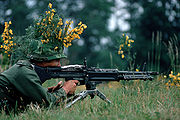 One of the more noticeable changes on the M60E1 is that the bipod attachment point was moved to the gas tube rather than the barrel (like on the later M60E3). It did not, however, have a forward pistol grip, as was added on the E3.
One of the more noticeable changes on the M60E1 is that the bipod attachment point was moved to the gas tube rather than the barrel (like on the later M60E3). It did not, however, have a forward pistol grip, as was added on the E3.
 The M60E2 is used on armored fighting vehicles, such as the M48A5, later M60 Patton
The M60E2 is used on armored fighting vehicles, such as the M48A5, later M60 Patton
versions and the K1 Type 88
. It lacks many of the external components of the standard M60, including stock and grips. The M60E2 was electrically fired, but had a manual trigger as a backup, as well as a metal loop at the back for charging
. The gas tube below the barrel was extended to the full length of the weapon to vent the gas outside the vehicle. This version achieved a mean time between failures of 1,669 during testing in the 1970s, more frequent than the FN MAG
, which was adopted in 1977 as a co-axial vehicle gun and designated the M240.
The M60E2 is used on the South Korea
's K1 Type 88
tank as a co-axial weapon, along with an M60D on a pintle mount.
 The M60C is a variant of the standard M60 for aircraft-mounting, such as in helicopter armament subsystems. It lacks things like the bipod, pistol grip, and iron sights
The M60C is a variant of the standard M60 for aircraft-mounting, such as in helicopter armament subsystems. It lacks things like the bipod, pistol grip, and iron sights
. The main difference between the standard M60 and the "C" variant is the electronic control system and the hydraulic swivel system used. It could be fired from the cockpit by the pilot or co-pilot. It is an electronically controlled, hydraulic-powered, air-cooled, gas-operated, belt-fed weapon system. It used the M2, M6, and M16 armament subsystems and was mounted on the OH-13 Sioux, the OH-23 Raven, the UH-1B Huey
, and comprised the standard fixed armament of the OV-10 Bronco
. M60C production was on the order of several hundred. It was also used in the XM19
gun pod
.
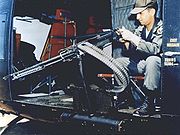 The M60D is a mounted version of the standard M60. It can be mounted on boats, vehicles and as a pintle-mounted door gun in helicopters. When used in aircraft, it differs from the M60C in that it is not controlled by the pilot—rather, it is mounted in a door and operated by a member of the crew. Like the rest of the M60 family, it is an air-cooled, gas-operated, belt-fed weapon. Unlike other models, however, the M60D normally has spade grips and an aircraft ring-type sight or similar, as well as an improved ammunition feed system. A canvas bag is also affixed to the gun to capture ejected casings and links, preventing them from being sucked into the rotor blades or into an engine intake. The M60D was equipped on the UH-1B Huey (using the M23, XM29, M59, and the Sagami mounts), the CH-47 Chinook
The M60D is a mounted version of the standard M60. It can be mounted on boats, vehicles and as a pintle-mounted door gun in helicopters. When used in aircraft, it differs from the M60C in that it is not controlled by the pilot—rather, it is mounted in a door and operated by a member of the crew. Like the rest of the M60 family, it is an air-cooled, gas-operated, belt-fed weapon. Unlike other models, however, the M60D normally has spade grips and an aircraft ring-type sight or similar, as well as an improved ammunition feed system. A canvas bag is also affixed to the gun to capture ejected casings and links, preventing them from being sucked into the rotor blades or into an engine intake. The M60D was equipped on the UH-1B Huey (using the M23, XM29, M59, and the Sagami mounts), the CH-47 Chinook
(using the M24 and M41 mounts) in both door and ramp locations, the ACH-47A "Guns-A-Go-Go" variant of the Chinook (using the XM32 and XM33 mounts), and on the UH-60 Black Hawk (using the M144 mount). The M60D is also used by the British on Royal Air Force Chinooks. In US service, the M60D are being replaced, primarily by the M240H.
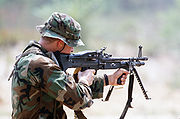 The M60E3 was fielded circa 1986 in an attempt to remedy problems with earlier versions of the M60 for infantry use. It is a lightweight, "improved" version intended to reduce the load carried by the gunner. Unlike its predecessors, the M60E3 has several updated modern features. It has a bipod (attached to the receiver) for improved stability, ambidextrous safety, universal sling attachments, a carrying handle on the barrel, and a simplified gas system. However, these features also caused almost as many problems for the weapon as they fixed. There were different types of barrels used, but the lightweight barrel was not as safe for sustained fire at 200 rounds per minute as heavier types. However, some personnel claim to have witnessed successful prolonged firing of the weapon. The stellite
The M60E3 was fielded circa 1986 in an attempt to remedy problems with earlier versions of the M60 for infantry use. It is a lightweight, "improved" version intended to reduce the load carried by the gunner. Unlike its predecessors, the M60E3 has several updated modern features. It has a bipod (attached to the receiver) for improved stability, ambidextrous safety, universal sling attachments, a carrying handle on the barrel, and a simplified gas system. However, these features also caused almost as many problems for the weapon as they fixed. There were different types of barrels used, but the lightweight barrel was not as safe for sustained fire at 200 rounds per minute as heavier types. However, some personnel claim to have witnessed successful prolonged firing of the weapon. The stellite
superalloy barrel liner makes it possible, but the excessive heat generated by this process can quickly make the gun unusable. There were two main barrels, a lightweight barrel and another heavier type—the former for when lighter weight was desired, and the latter for situations where more sustained fire was required.
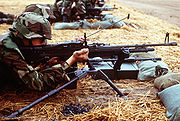 The reduced-weight components also reduced the durability of the weapon, making it more prone to rapid wear and parts breakage than the original. Most infantry
The reduced-weight components also reduced the durability of the weapon, making it more prone to rapid wear and parts breakage than the original. Most infantry
units in the U.S. Army and Marine Corps have now switched over to the M240 as their general-purpose machine gun, which is more reliable (particularly when dirty) and seems to be well liked by the troops for its ruggedness, despite the fact that it weighs 27.6 lb (12.5 kg) compared to the standard M60 at 23.15 lb (10.5 kg).
The U.S. Air Force Security Forces received the M60E3 from 1988 to 1989. All USAF M60E3s were withdrawn from general issue by 1990, because it did not meet the vehicle mount requirements of the Cadillac Gage Ranger
and due to overheating problems. The M60E3 did remain in the Air Force as an emergency issue weapon only. The Air Force cut the barrel change times, sustained fire 100 rounds per minute change barrel every 10 minutes (M-60) to 5 minutes (M-60E3), and rapid fire 200 rounds per minute change barrel every 5 minutes to 2 minutes.
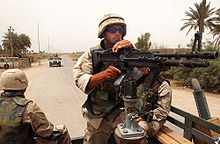 The Navy has designated this weapon as the MK 43 Mod 0. It was developed for the U.S. Navy SEALs to replace their existing stock of M60E3 machine guns fitted with shorter "assault barrels". These weapons are identical to standard M60E4s, with the exception of the barrel length, and can be used either as suppressive fire or direct fire weapons. The MK 43 Mod 1 adds significantly more rail attachment points to the weapon's receiver cover and handguard.
The Navy has designated this weapon as the MK 43 Mod 0. It was developed for the U.S. Navy SEALs to replace their existing stock of M60E3 machine guns fitted with shorter "assault barrels". These weapons are identical to standard M60E4s, with the exception of the barrel length, and can be used either as suppressive fire or direct fire weapons. The MK 43 Mod 1 adds significantly more rail attachment points to the weapon's receiver cover and handguard.
U.S. Ordnance website states in their FAQ, as of 2005, that the "M60E4 and the MK 43 are the same weapon system". The M60E4 and MK 43 versions in the past were roughly similar, although they are part of the same family. While it might be fair to say that the Mk 43s are a type of M60E4, there are technical differences between any given M60E4 model. Early MK 43s have certain differences over M60E4 from the same period, the most obvious being the duck-bill flash hider and different handguard. This difference is no longer seen on the current MK 43s.
In Army trials during the 1990s the M60E4 produced by Saco Defense was pitted against the (then called) M240E4 produced by FN for a new medium machine gun to be used by the infantry. The competition was to replace the decades-old M60s. The M240E4 won, and was then classified as the M240B. While the M240B had been more reliable in the tests, it was noted to be a heavier weapon than the M60E4.
The M60E4/MK 43 is a modern update to the entire series, such that it is also available in many of the previous configurations, such as a co-axial weapon. Kits are offered to convert older models to the E4 standard.
.
versions for the civilian market have been produced in the United States. The internals must be extensively modified to make it essentially impossible to convert them to fully automatic weapons. If the design is approved by the U.S. Bureau of Alcohol, Tobacco, Firearms and Explosives
(BATFE), they are treated as belt-fed semi-automatic rifles; however, individual state and local regulations still apply.
The U.S. Ordnance company is the current maker authorized by Saco to produce mil-spec
M60s and M60 parts. However, U.S. Ordnance put its civilian semi-auto sales on hold until 2006 because its production capacity is required for government orders. The company had charged $8000 for a new semi-automatic M60.
The Desert Ordnance company is a current maker of M60s and M60 parts. The company charges between $13000-$14000 for a new semi-automatic M60, depending on the model.
Various makes of older fully automatic versions are on the market as well, but there are many legal requirements to be met before purchasing them, and they cost upwards of U.S. $20,000–30,000. This is largely due to the restriction on the production of fully automatic firearms in the U.S. for the general civilian market since 1986. The combination of banning production and importation has led many to think it is illegal to own a machine gun, when, in fact, it is legal to own and use a fully automatic M60 machine gun in the United States (unless prohibited by other state or local laws).
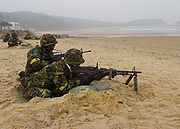
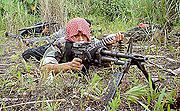
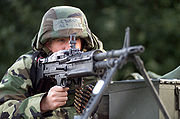
United States
The United States of America is a federal constitutional republic comprising fifty states and a federal district...
general-purpose machine guns firing 7.62×51mm NATO
7.62×51mm NATO
The 7.62×51mm NATO is a rifle cartridge developed in the 1950s as a standard for small arms among NATO countries...
cartridges
Cartridge (firearms)
A cartridge, also called a round, packages the bullet, gunpowder and primer into a single metallic case precisely made to fit the firing chamber of a firearm. The primer is a small charge of impact-sensitive chemical that may be located at the center of the case head or at its rim . Electrically...
from a disintegrating belt
Belt (firearm)
A belt or ammunition belt is a device used to retain and feed cartridges into a firearm. Belts and the associated feed systems are typically employed to feed machine guns or other automatic weapons...
of M13 link
M13 link
The M13 link, formally Link, M13, is the U.S. military designation for a disintegrating metallic link specifically designed for belt-fed firearms and rounds; it was introduced in the mid-20th century. It is the primary link type for the U.S., and among NATO for 7.62 mm ammunition...
s. There are several types of live ammunition approved for use in the M60, including ball
Full metal jacket bullet
A full metal jacket is a bullet consisting of a soft core encased in a shell of harder metal, such as gilding metal, cupronickel or less commonly a steel alloy. This shell can extend around all of the bullet, or often just the front and sides with the rear left as exposed lead...
, tracer
Tracer ammunition
Tracer ammunition are bullets that are built with a small pyrotechnic charge in their base. Ignited by the burning powder, the phosphorus tail burns very brightly, making the projectile visible to the naked eye...
, and armor-piercing
Armor-piercing shot and shell
An armor-piercing shell is a type of ammunition designed to penetrate armor. From the 1860s to 1950s, a major application of armor-piercing projectiles was to defeat the thick armor carried on many warships. From the 1920s onwards, armor-piercing weapons were required for anti-tank missions...
rounds.
Introduced in 1957, it has served with every branch of the U.S. military
United States armed forces
The United States Armed Forces are the military forces of the United States. They consist of the Army, Navy, Marine Corps, Air Force, and Coast Guard.The United States has a strong tradition of civilian control of the military...
and still serves with other armed forces. Its manufacture and continued upgrade for military and commercial purchase continues into the 21st century, though it has been replaced or supplemented in most roles by other designs, notably the M240
M240
The M240, officially Machine Gun, 7.62mm, M240, is the US military designation for the FN MAG , a family of belt-fed, gas-operated medium machine guns firing the 7.62x51mm NATO cartridge.The M240 has been used by the United States Armed Forces since the mid-1980s...
in U.S. service.
Overview
The M60 is a belt-fed machine gun that fires the 7.62 mm NATO cartridge (.308 winchester) commonly used in larger rifles. It is generally used as crew-served weaponCrew served weapon
A crew-served weapon is any weapon system that requires a crew of more than one individual to function at optimum efficiency due to its operational complexity, such as requiring one person to load while another fires. The weight and bulk of the system often also necessitates multiple personnel for...
and operated by a team of two or three individuals. The team consists of the gunner, the assistant gunner (AG in military slang), and the ammunition bearer. The gun's weight and the amount of ammunition it consumes when fired make it difficult for a single soldier to carry and operate. The gunner carries the weapon and, depending on his strength and stamina, anywhere from 200 to 1000 rounds of ammunition. The assistant carries a spare barrel
Gun barrel
A gun barrel is the tube, usually metal, through which a controlled explosion or rapid expansion of gases are released in order to propel a projectile out of the end at a high velocity....
and extra ammunition
Ammunition
Ammunition is a generic term derived from the French language la munition which embraced all material used for war , but which in time came to refer specifically to gunpowder and artillery. The collective term for all types of ammunition is munitions...
, and reloads and spots targets for the gunner. The ammunition bearer carries additional ammunition and the tripod with associated traversing and elevation mechanism, if issued, and fetches more ammunition as needed during firing.

M2 Tripod
The M2 Tripod is a U.S. machine gun tripod originally used with the Browning M1919 infantry machine gun. Since then, it has seen several redesigns, but remained largely the same. In this fashion, the M2 tripod has seen combat service in every conflict the U.S. Army and Marine Corps has been...
, and some other mounts.
M60 ammunition comes in a cloth bandolier
Bandolier
A bandolier or a bandoleer is a pocketed belt for holding ammunition. It was usually slung over the chest. In its original form, it was common issue to soldiers from the 16th to 18th centuries. This was very useful for quickly reloading a musket....
containing a cardboard box of 100 pre-linked rounds. The M60 changed from M1 link to the different M13 link, a change from the older link system with which it was not compatible. The cloth bandolier is reinforced to allow it to be hung from the current version of the feed tray. Historically, units in Vietnam used B3A cans from C-ration
C-ration
The C-Ration, or Type C ration, was an individual canned, pre-cooked, or prepared wet ration intended to be issued to U.S. military land forces when fresh food or packaged unprepared food prepared in mess halls or field kitchens was impractical or not available, and when a survival ration was...
s packs locked into the ammunition box attachment system to roll the ammunition belts over for a straighter and smoother feed to the loading port to enhance reliability of feed. The later models changed the ammunition box attachment point and made this adaptation unnecessary.
History
The M60 machine gun began development in the late 1940s as a program for a new, lighter 7.62 mm machine gun. It was derived from German machine guns of World War II (most notably the FG 42FG 42
The FG 42 was a selective fire battle rifle produced in Nazi Germany during World War II...
and to a lesser extent the MG 42), but it contained American innovations as well. Early prototypes, notably the T52 and T161 bore a close resemblance to both the M1941 Johnson machine gun and the FG-42. It was intended to replace the M1918 Browning Automatic Rifle and M1919A6 Browning machine gun
M1919 Browning machine gun
The M1919 Browning is a .30 caliber medium machine gun that was widely used during the 20th century. It was used as a light infantry, coaxial, mounted, aircraft, and anti-aircraft machine gun by the U.S. and many other countries, especially during World War II, the Korean War, and the Vietnam War...
in the squad automatic weapon role, and in the medium machine gun role. One of the weapons tested against it during its procurement process was the FN MAG
FN MAG
The FN MAG is a Belgian 7.62 mm general-purpose machine gun, designed in the early 1950s at Fabrique Nationale by Ernest Vervier. It has been used by more than 80 countries, and it has been made under licence in countries such as Argentina, Egypt, India, Singapore, the United Kingdom and the...
.

United States Army
The United States Army is the main branch of the United States Armed Forces responsible for land-based military operations. It is the largest and oldest established branch of the U.S. military, and is one of seven U.S. uniformed services...
officially adopted the M60 in 1957. It later served in the Vietnam War
Vietnam War
The Vietnam War was a Cold War-era military conflict that occurred in Vietnam, Laos, and Cambodia from 1 November 1955 to the fall of Saigon on 30 April 1975. This war followed the First Indochina War and was fought between North Vietnam, supported by its communist allies, and the government of...
as a squad automatic weapon
Squad automatic weapon
A squad automatic weapon is a weapon used to give infantry squads or sections a portable source of automatic firepower. Weapons used in this role are selective-fire rifles, usually fitted with a bipod and heavier barrel to perform as Light machine guns...
with many U.S. units. Every soldier in the rifle squad would carry an additional 200 linked rounds of ammunition for the M60, a spare barrel, or both. The up-gunned M113 armored personnel carrier
M113 armored personnel carrier
The M113 is a fully tracked armored personnel carrier that has formed the backbone of the United States Army's mechanized infantry units from the time of its first fielding in Vietnam in April 1962. The M113 was the most widely used armored vehicle of the U.S...
ACAV added two M60 gunners beside the main .50 caliber machine gun, and the Patrol Boat, River
Patrol Boat, River
Patrol Boat, River , or PBR, is the United States Navy designation for a small rigid-hulled patrol boat used in the Vietnam War from March 1966 until the end of 1971...
had one in addition to two .50 cal mounts.

Vietnam War
The Vietnam War was a Cold War-era military conflict that occurred in Vietnam, Laos, and Cambodia from 1 November 1955 to the fall of Saigon on 30 April 1975. This war followed the First Indochina War and was fought between North Vietnam, supported by its communist allies, and the government of...
, the M60 received the nickname "The Pig" due to its size.
In the 1980s, the M60 was partially replaced by the M249 Squad Automatic Weapon
M249 light machine gun
The M249 light machine gun , previously designated the M249 Squad Automatic Weapon , and formally written as Light Machine Gun, 5.56 mm, M249, is an American version of the Belgian FN Minimi, a light machine gun manufactured by the Belgian company FN Herstal . The M249 is manufactured in the...
within the infantry squad. The M60 was retained in the vehicle mounted role and the general-purpose role due to its greater power and range compared to the 5.56 mm
5.56x45mm NATO
5.56×45mm NATO is a rifle cartridge developed in the United States and originally chambered in the M16 rifle. Under STANAG 4172, it is a standard cartridge for NATO forces as well as many non-NATO countries. It is derived from, but not identical to, the .223 Remington cartridge...
M249. In United States Marine Corps
United States Marine Corps
The United States Marine Corps is a branch of the United States Armed Forces responsible for providing power projection from the sea, using the mobility of the United States Navy to deliver combined-arms task forces rapidly. It is one of seven uniformed services of the United States...
service, concerns about the M60's reliability, weight, and the high round counts of many M60s in service prompted the adoption of the M60E4 (or also known as MK43MG) to replace most original M60s in infantry units.


United States Navy SEALs
The United States Navy's Sea, Air and Land Teams, commonly known as Navy SEALs, are the U.S. Navy's principal special operations force and a part of the Naval Special Warfare Command as well as the maritime component of the United States Special Operations Command.The acronym is derived from their...
and as a door gun on U.S. Army helicopters, and was the main 7.62 mm machine gun by some U.S. special operations forces
Special forces
Special forces, or special operations forces are terms used to describe elite military tactical teams trained to perform high-risk dangerous missions that conventional units cannot perform...
to the late 1990s. As of 2005, it is used by the Coast Guard
United States Coast Guard
The United States Coast Guard is a branch of the United States Armed Forces and one of the seven U.S. uniformed services. The Coast Guard is a maritime, military, multi-mission service unique among the military branches for having a maritime law enforcement mission and a federal regulatory agency...
, Navy, and a some reserve units, though it is being phased out in favor of the M240 7.62 mm medium machine gun. Its use as an Army helicopter door gun will soon taper off, as an improved M240 version has been adopted for this role.
Design
The M60 is a gas-operated, air-cooled, belt-fed, automaticAutomatic firearm
An automatic firearm is a firearm that loads another round mechanically after the first round has been fired.The term can be used to refer to semi-automatic firearms, which fire one shot per single pull of the trigger , or fully automatic firearms, which will continue to load and fire ammunition...
machine gun that fires from the open-bolt position and is chambered for the 7.62 mm NATO cartridge. Ammunition is usually fed into the weapon from a 100-round bandolier
Bandolier
A bandolier or a bandoleer is a pocketed belt for holding ammunition. It was usually slung over the chest. In its original form, it was common issue to soldiers from the 16th to 18th centuries. This was very useful for quickly reloading a musket....
containing a disintegrating, metallic split-link belt.

MG42
The MG 42 is a 7.9mm universal machine gun that was developed in Nazi Germany and entered service with the Wehrmacht in 1942...
with a single pawl), quick barrel replacement, a pistol grip
Pistol grip
On a firearm or other tool, the pistol grip is that portion of the mechanism that is held by the hand and orients the hand in a forward, vertical orientation, similar to the position one would take with a conventional pistol such as the M1911....
and stock
Stock (firearm)
A stock, also known as a buttstock or shoulder stock, is a part of a rifle or other firearm, to which the barrel and firing mechanism are attached, that is held against one's shoulder when firing the gun. Stocks are also found on crossbows though a crossbow stock is more properly referred to as a...
, and a Semi bullpup design similar to the FG42 (much of the action occupies the weapon's stock). The M60's operating system of an operating rod turning a rotating bolt was inspired by the FG42, which was based on the much earlier Lewis Gun
Lewis Gun
The Lewis Gun is a World War I–era light machine gun of American design that was perfected and widely used by the British Empire. It was first used in combat in World War I, and continued in service with a number of armed forces through to the end of the Korean War...
. The M60's gas operation is unique, and drew on technical advances of the period, particularly the White "gas expansion and cutoff" principle also exploited by the M14 rifle. The M60's gas system was simpler than other gas systems and easier to clean.
The straight-line layout allowed the operating rod and buffer to run directly back into the buttstock and reduce the overall length of the weapon.
As with all such weapons, it can be fired from the shoulder, hip, or underarm position. However, to achieve the maximum effective range, it is recommended that a bipod-steadied position or a tripod-mounted position be used and fired in bursts of 3–5 rounds. The weapon is heavy and difficult to aim when firing without support, though the weight helps reduce the felt recoil. The large grip also allowed the weapon to be conveniently carried at the hip. The gun can be stripped using a live round of ammunition as a tool. However, this is highly discouraged, as doing so can damage that round and increase the chance of a misfire.
The M60 is often used with its own integrated bipod or with the M122 tripod
M2 Tripod
The M2 Tripod is a U.S. machine gun tripod originally used with the Browning M1919 infantry machine gun. Since then, it has seen several redesigns, but remained largely the same. In this fashion, the M2 tripod has seen combat service in every conflict the U.S. Army and Marine Corps has been...
. The M60 is considered effective up to 1,100 meters when firing at an area target and mounted on a tripod
Tripod
A tripod is a portable three-legged frame, used as a platform for supporting the weight and maintaining the stability of some other object. The word comes from the Greek tripous, meaning "three feet". A tripod provides stability against downward forces, horizontal forces and moments about the...
; up to 800 meters when firing at an area target using the integral bipod
Bipod
A bipod is a support device that is similar to a tripod or monopod, but with two legs. It provides significant stability along two axes of motion .-Firearms:...
; up to 600 meters when firing at a point target; and up to 200 meters when firing at a moving point target. United States Marine Corps
United States Marine Corps
The United States Marine Corps is a branch of the United States Armed Forces responsible for providing power projection from the sea, using the mobility of the United States Navy to deliver combined-arms task forces rapidly. It is one of seven uniformed services of the United States...
doctrine
Doctrine
Doctrine is a codification of beliefs or a body of teachings or instructions, taught principles or positions, as the body of teachings in a branch of knowledge or belief system...
holds that the M60 and other weapons in its class are capable of suppressive fire
Suppressive fire
In military science, suppressive fire is a fire that degrades the performance of a target below the level needed to fulfill its mission. Suppression is usually only effective for the duration of the fire. Suppressive fire is not always a direct form of fire towards targets; it can be an effective...
on area targets out to 1,500 meters if the gunner is sufficiently skilled.
Originally an experimental M91 tripod was developed for the M60, but an updated M2 tripod design was selected over it which became the M122. The M122 would be itself replaced in the 2000s by a new mount, in time for the M60 to also be used with it.
Ammunition


Tracer ammunition
Tracer ammunition are bullets that are built with a small pyrotechnic charge in their base. Ignited by the burning powder, the phosphorus tail burns very brightly, making the projectile visible to the naked eye...
, and M80 Ball. For training purposes, M63 Dummy and M82 Blanks
Blank (cartridge)
A blank is a type of cartridge for a firearm that contains gunpowder but no bullet or shot. When fired, the blank makes a flash and an explosive sound . Blanks are often used for simulation , training, and for signaling...
are used. The new tungsten
Tungsten
Tungsten , also known as wolfram , is a chemical element with the chemical symbol W and atomic number 74.A hard, rare metal under standard conditions when uncombined, tungsten is found naturally on Earth only in chemical compounds. It was identified as a new element in 1781, and first isolated as...
cored M993 Armor-piercing rounds may also be fired in the M60 as well, though they did not enter the inventory until after the M60 was withdrawn from service in active-duty units.
When firing blanks, the M13 or M13A1 blank-firing adaptor
Blank-firing adaptor
A blank-firing adaptor or blank-firing attachment , sometimes called a blank adaptor or blank attachment, is a device used in conjunction with blank ammunition. Blank firing adapters are required for allowing blanks to cycle most automatic firearms.-Design:The design of the blank firing adapter...
(BFA) is necessary in order to produce enough gas pressure to cycle the weapon with blanks. All ammunition must be fixed in a NATO standard M13 disintegrating metallic split-link belt to feed into the weapon.
The standard combat ammunition mix for the M60 consists of four ball (M80) cartridges and one tracer (M62) in belts of 100 rounds. The four to one ratio theoretically allows the gunner to accurately "walk" the fire into the enemy. Tracer bullets do not fly quite the same trajectory as ball and weapon's sights must be used for accurate fire—particularly at ranges in excess of 800 meters, where 7.62x51mm NATO tracer bullets usually burn out and are no longer visible. This is a problem for all weapons in this caliber using this tracer round.
Design flaws

Southeast Asia
Southeast Asia, South-East Asia, South East Asia or Southeastern Asia is a subregion of Asia, consisting of the countries that are geographically south of China, east of India, west of New Guinea and north of Australia. The region lies on the intersection of geological plates, with heavy seismic...
in which it was soon used, the initial versions displayed several potential problems when used on the ground. A common complaint was the weapon's weight, though M60 was among the lightest 7.62 mm machine guns of the era.
For units in Vietnam, the single most common complaint was that the M60 was comparatively unreliable and prone to jamming and other malfunctions, especially when it was dirty. Fine sand and dust in the mechanism could bring the M60 to a halt. This was a major factor in the Israeli Defense Force declining to adopt the M60 in favor for the FN MAG
FN MAG
The FN MAG is a Belgian 7.62 mm general-purpose machine gun, designed in the early 1950s at Fabrique Nationale by Ernest Vervier. It has been used by more than 80 countries, and it has been made under licence in countries such as Argentina, Egypt, India, Singapore, the United Kingdom and the...
. The weapon was more difficult to clean and maintain than the M1918A2 Browning Automatic Rifle (BAR) it replaced in the squad. In normal conditions it would often fire thousands of rounds without a serious jam, while field conditions tended to reduce reliability without proper maintenance.
The safety was awkward to operate and worked the "wrong way" for soldiers who were trained with the M16 rifle and M1911A1 pistol—that is, it required an upward movement of the thumb on the safety catch to make the gun ready to fire, rather than a downward movement as with the other weapons. Additionally, it is possible to install parts of the fire control mechanism incorrectly, causing a "runaway gun"—meaning that it would keep firing until empty even if the operator took his finger off the trigger. The gas system of the original model could be assembled incorrectly causing failure to function and could unscrew and come apart if not safety wire
Safety wire
Safety wire or lockwire is common in the aircraft and racing industries as an extra precaution to keep vital fasteners from unintentionally loosening and parts from falling off due to vibration or other forces. The use of safety wire is a type of positive locking device. It also allows rapid and...
d in place.

The grip/trigger housing assembly is held in place with a rather fragile leaf spring clip instead of the captive pins used in other designs. The spring clip has been known to be prone to breakage since the first trials at Aberdeen Proving Ground. Duct tape and cable ties have been seen on M60s in the field, placed there by their crews in case the spring clip breaks. The sear
Sear (firearm)
In a firearm, the sear is the part of the trigger mechanism which holds the hammer or striker back until the correct amount of pressure has been applied to the trigger; at which point the hammer or striker is released to discharge the weapon...
in the trigger mechanism gained a reputation for wearing down and a malfunction could cause the gun to "run away". A second sear notch was eventually added to the operating rod to reduce the chance of this happening.
Several critical parts of early production M60s, such as the receiver
Receiver (firearms)
In firearms terminology, the receiver is the part of a firearm that houses the operating parts. The receiver usually contains the bolt carrier group, trigger group, and magazine port. In most handguns, the receiver, or frame, holds the magazine well or rotary magazine as well as the trigger mechanism...
cover and feed tray, were made from very thin sheet metal stampings and prone to bending or breaking; sturdier parts were eventually available in the early 1970s. Early M60s also had driving spring guides and operating rods that were too thin and gas pistons that were too narrow behind the piston head (part of an attempt to save weight), leading to problems with breakage. Metallurgical problems also played a part, (blamed by some on low-bid contractors), but after 1970 a slightly heavier part was designed and slowly put into the supply chain. High-round-count weapons were also susceptible to stretching of the receiver and other parts.

There was no handle to hold the barrel by for changes. A large asbestos
Asbestos
Asbestos is a set of six naturally occurring silicate minerals used commercially for their desirable physical properties. They all have in common their eponymous, asbestiform habit: long, thin fibrous crystals...
glove was part of the standard issue to allow the crew to handle hot barrels during barrel change. Loss of the glove was always a problem.
U.S. Marines especially disliked the M60, and many Marine units held onto their BARs
Browning Automatic Rifle
The Browning Automatic Rifle was a family of United States automatic rifles and light machine guns used by the United States and numerous other countries during the 20th century. The primary variant of the BAR series was the M1918, chambered for the .30-06 Springfield rifle cartridge and designed...
until 1967–68 officially, and longer unofficially. The M60E3 variant designed in the mid-1980s for the U.S. Marine Corps, reduced the design's weight to 18.9 lb (8.61 kg) unloaded and slightly improved reliability. Users complained about the quickly overheating barrel, a common problem with the original M60. This problem was aggravated in the M60E3, which uses a lighter barrel, which required changing every 100 rounds instead of every 200. The M60E3's barrel used a wire-and-plastic handle near the breech end and could be changed safely without the use of heat-resistant mittens.
The U.S. Navy special operations forces continued to use the M60E3 for years because of its portability and low weight for its caliber, with a number of upgrades, including a change in feed system and barrel configuration. Additional required changes were the addition of rails for optical sights and other modern accessories.
The reliability problem with the M60 machine gun was even more evident when the gun was compared to the successful and reliable PK machine gun
PK machine gun
The PK is a 7.62 mm general-purpose machine gun designed in the Soviet Union and currently in production in Russia. The PK machine gun was introduced in the 1960s and replaced the SGM and RPD machine guns in Soviet service...
used by Warsaw Pact
Warsaw Pact
The Warsaw Treaty Organization of Friendship, Cooperation, and Mutual Assistance , or more commonly referred to as the Warsaw Pact, was a mutual defense treaty subscribed to by eight communist states in Eastern Europe...
forces and Soviet client states, the German MG 42 from WWII and its derivatives such as the MG3, or to the FN MAG that as the M240 would eventually replace the M60.
Variants

Major variations include the M60E1 (an improved version that did not enter production), the M60E2 (a version designed to be used from fixed mounts as a co-axial for armored vehicles or in helicopter armament systems), the M60E3 (a lightweight version) and the M60E4 (another improved version, designated Mk 43 Mod 0 by the U.S. Navy
United States Navy
The United States Navy is the naval warfare service branch of the United States Armed Forces and one of the seven uniformed services of the United States. The U.S. Navy is the largest in the world; its battle fleet tonnage is greater than that of the next 13 largest navies combined. The U.S...
).
The M60C was adopted for use on fixed mounts on aircraft. It was characterized by the use of an electric solenoid to operate the trigger and a hydraulic system to charge the weapon. The M60D differed from the base model by employing spade grips, a different sighting system, and lacking a forearm. It was typically employed as a door gun on helicopters or as a pintle mounted weapon as on the Type 88 K1
K1 Type 88
The K1 is a South Korean third-generation main battle tank in use with the Republic of Korea Armed Forces, developed by Hyundai Precision...
tank.
There are many smaller variants among each type, between makers of the firearm, and over time.
Variant summary
- T161: The M60's developmental designation before it was type-classified in the 1950s.
- M60: The basic model, type-classified in 1957.
- M60E1: An improved version that did not enter production. The primary difference was the handle fixed to the barrel and the removal of the gas cylinder and bipod from the barrel assembly.
- M60E2: Used in vehicles as a coaxial machine gun; electrically fired.
- M60B: Used in helicopters in the 1960s and 1970s; unmounted.
- M60C: Used in fixed mounts in aircraft in the 1960s and 1970s; electrically fired and hydraulically charged.
- M60D: Replaced the M60B; a pintle-mounted version used especially in armament subsystem for helicopters, but also some other roles.
- M60E3: An updated, lightweight version adopted in the 1980s.
- M60E4 (Mk43 Mod 0/1): An improved model of the 1990s that looks similar to the E3, but has many improvements. It has subvariants of its own, and is also used by the U.S. Navy (as the Mk 43 Mod 0/1). The Mk 43 Mod 1 is a specialized version with additions such as extra rails for mounting accessories.
M60

The model was type-classified in 1957, and entered production. It saw its first heavy use in the 1960s. The basic design has undergone some smaller changes, and has been produced by different manufacturers.
M60E1
The M60E1 was the first major variant of the original M60. It did not go into full-scale production, though many of its features were included into the later E3 and E4 variants. Some of its features were also incorporated into the existing M60 production. This mainly changed how the gas cylinder, the barrel, and the bipod were connected; in the first iteration. The M60 and the M60E1 are two different versions. Opinions are varied on whether the M60E1 was officially adopted or not.
M60E2

M60 Patton
The 105 mm Gun Full Tracked Combat Tank, M60, also known unofficially as the M60 Patton, is a first-generation main battle tank introduced in December 1960. It was widely used by the U.S. and its Cold War allies, especially those in NATO, and remains in service throughout the world today...
versions and the K1 Type 88
K1 Type 88
The K1 is a South Korean third-generation main battle tank in use with the Republic of Korea Armed Forces, developed by Hyundai Precision...
. It lacks many of the external components of the standard M60, including stock and grips. The M60E2 was electrically fired, but had a manual trigger as a backup, as well as a metal loop at the back for charging
Cocking handle
The cocking handle is a device on a firearm which, when operated, results in the hammer or striker being cocked or moved to the ready position...
. The gas tube below the barrel was extended to the full length of the weapon to vent the gas outside the vehicle. This version achieved a mean time between failures of 1,669 during testing in the 1970s, more frequent than the FN MAG
FN MAG
The FN MAG is a Belgian 7.62 mm general-purpose machine gun, designed in the early 1950s at Fabrique Nationale by Ernest Vervier. It has been used by more than 80 countries, and it has been made under licence in countries such as Argentina, Egypt, India, Singapore, the United Kingdom and the...
, which was adopted in 1977 as a co-axial vehicle gun and designated the M240.
The M60E2 is used on the South Korea
South Korea
The Republic of Korea , , is a sovereign state in East Asia, located on the southern portion of the Korean Peninsula. It is neighbored by the People's Republic of China to the west, Japan to the east, North Korea to the north, and the East China Sea and Republic of China to the south...
's K1 Type 88
K1 Type 88
The K1 is a South Korean third-generation main battle tank in use with the Republic of Korea Armed Forces, developed by Hyundai Precision...
tank as a co-axial weapon, along with an M60D on a pintle mount.
M60B
The M60B was a short-lived version designed to be fired from helicopters, with limited deployment made in the 1960s and 1970s. It was not mounted, just held, and was soon replaced by the pintle-mounted M60D. The 'B' model differed most noticeably in that it had no bipod and featured a different rear stock than the regular model. It still had a pistol grip (as opposed to spade grips). The M60B's advantage over pintle-mounted variants was that it had a wider and much less restricted field of fire.M60C

Iron sights
Iron sights are a system of shaped alignment markers used as a sighting device to assist in the aiming of a device such as a firearm, crossbow, or telescope, and exclude the use of optics as in telescopic sights or reflector sights...
. The main difference between the standard M60 and the "C" variant is the electronic control system and the hydraulic swivel system used. It could be fired from the cockpit by the pilot or co-pilot. It is an electronically controlled, hydraulic-powered, air-cooled, gas-operated, belt-fed weapon system. It used the M2, M6, and M16 armament subsystems and was mounted on the OH-13 Sioux, the OH-23 Raven, the UH-1B Huey
UH-1 Iroquois
The Bell UH-1 Iroquois is a military helicopter powered by a single, turboshaft engine, with a two-bladed main rotor and tail rotor. The helicopter was developed by Bell Helicopter to meet the United States Army's requirement for a medical evacuation and utility helicopter in 1952, and first flew...
, and comprised the standard fixed armament of the OV-10 Bronco
OV-10 Bronco
The North American Aviation Rockwell OV-10 Bronco is a turboprop light attack and observation aircraft. It was developed in the 1960s as a special aircraft for counter-insurgency combat, and one of its primary missions was as a forward air control aircraft...
. M60C production was on the order of several hundred. It was also used in the XM19
U.S. aircraft gun pods
The idea of the gun pod as a concept largely came into its prime during and period following World War II. So-called "package gun" installations on US medium and light bombers, such as the B-25 Mitchell and A-26 Invader, were probably the first such attempts by the United States military...
gun pod
Gun pod
A gun pod is a detachable pod or pack containing machine guns or automatic cannon and ancillaries, mounted externally on a vehicle such as a military aircraft which may or may not also have its own guns....
.
M60D

CH-47 Chinook
The Boeing CH-47 Chinook is an American twin-engine, tandem rotor heavy-lift helicopter. Its top speed of 170 knots is faster than contemporary utility and attack helicopters of the 1960s...
(using the M24 and M41 mounts) in both door and ramp locations, the ACH-47A "Guns-A-Go-Go" variant of the Chinook (using the XM32 and XM33 mounts), and on the UH-60 Black Hawk (using the M144 mount). The M60D is also used by the British on Royal Air Force Chinooks. In US service, the M60D are being replaced, primarily by the M240H.
M60E3

Stellite
Stellite alloy is a range of cobalt-chromium alloys designed for wear resistance. It may also contain tungsten or molybdenum and a small but important amount of carbon...
superalloy barrel liner makes it possible, but the excessive heat generated by this process can quickly make the gun unusable. There were two main barrels, a lightweight barrel and another heavier type—the former for when lighter weight was desired, and the latter for situations where more sustained fire was required.

Infantry
Infantrymen are soldiers who are specifically trained for the role of fighting on foot to engage the enemy face to face and have historically borne the brunt of the casualties of combat in wars. As the oldest branch of combat arms, they are the backbone of armies...
units in the U.S. Army and Marine Corps have now switched over to the M240 as their general-purpose machine gun, which is more reliable (particularly when dirty) and seems to be well liked by the troops for its ruggedness, despite the fact that it weighs 27.6 lb (12.5 kg) compared to the standard M60 at 23.15 lb (10.5 kg).
The U.S. Air Force Security Forces received the M60E3 from 1988 to 1989. All USAF M60E3s were withdrawn from general issue by 1990, because it did not meet the vehicle mount requirements of the Cadillac Gage Ranger
Cadillac Gage Ranger
The Cadillac Gage Ranger is a 4×4 armored personnel carrier produced by Cadillac Gage. The largest customer was the United States Air Force which at one time had over 700. It is also used by Luxembourg and Indonesia...
and due to overheating problems. The M60E3 did remain in the Air Force as an emergency issue weapon only. The Air Force cut the barrel change times, sustained fire 100 rounds per minute change barrel every 10 minutes (M-60) to 5 minutes (M-60E3), and rapid fire 200 rounds per minute change barrel every 5 minutes to 2 minutes.
M60E4/Mk43 Mod 0/1
This firearm is the most modernized and latest in the generations of the old M60 family and incorporates a number of improvements over past versions. Externally, it looks somewhat like the M60E3, but it has many internal changes and improvements that modernize the effectiveness and reliability of this weapon, in general it is a more reliable weapon than all previous M60s. Externally, It features a different forward grip, iron sights, butt stock and bipod. The M60E4/MK 43 has higher pull for the belt, and is available in a variety of configurations. Older M60 models can be upgraded with a conversion kit manufactured by U.S. Ordnance to the M60E4/MK 43. The M60E4/MK 43 were primarily developed in the 1990s and have continued to be redeveloped in the 2000's. Early MK 43s had some distinct differences from the E4 (such as a duckbill flash suppressor), though by the 2000s these distinctions seemed to have ended.
U.S. Ordnance website states in their FAQ, as of 2005, that the "M60E4 and the MK 43 are the same weapon system". The M60E4 and MK 43 versions in the past were roughly similar, although they are part of the same family. While it might be fair to say that the Mk 43s are a type of M60E4, there are technical differences between any given M60E4 model. Early MK 43s have certain differences over M60E4 from the same period, the most obvious being the duck-bill flash hider and different handguard. This difference is no longer seen on the current MK 43s.
In Army trials during the 1990s the M60E4 produced by Saco Defense was pitted against the (then called) M240E4 produced by FN for a new medium machine gun to be used by the infantry. The competition was to replace the decades-old M60s. The M240E4 won, and was then classified as the M240B. While the M240B had been more reliable in the tests, it was noted to be a heavier weapon than the M60E4.
The M60E4/MK 43 is a modern update to the entire series, such that it is also available in many of the previous configurations, such as a co-axial weapon. Kits are offered to convert older models to the E4 standard.
- M60E4 (Light machine gun):
- Short barrel: weight: 22.5 lb (10.2 kg); length: 37.7 in (95.8 cm)
- Long barrel: weight: 23.1 lb (10.5 kg); length: 42.4 in (108 cm)
- Assault barrel: weight: 21.3 lb (9.66 kg); length: 37.0 in (94.0 cm)
- Width: 4.8 in (12.2 cm)
- M60E4 (mounted):
- Length: 43.5 in (110 cm)
- Width: 5.9 in (15.0 cm)
- Weight: 22.7 lb (10.3 kg)
- M60E4 (co-axial):
- Length: 42.3 in (107 cm)
- Width: 4.8 in (12.2 cm)
- Weight: 21.2 lb (9.62 kg)
5.56 mm derivatives
Scaled down derivatives of the M60 machine gun also existed as the Ford Aerospace XM234 and Rodman Laboratories XM235 as a replacement for the M1918 Browning Automatic Rifle. Both weapons lost to the FN MinimiM249 light machine gun
The M249 light machine gun , previously designated the M249 Squad Automatic Weapon , and formally written as Light Machine Gun, 5.56 mm, M249, is an American version of the Belgian FN Minimi, a light machine gun manufactured by the Belgian company FN Herstal . The M249 is manufactured in the...
.
Civilian versions
A number of semi-automaticSemi-automatic firearm
A semi-automatic, or self-loading firearm is a weapon which performs all steps necessary to prepare the weapon to fire again after firing—assuming cartridges remain in the weapon's feed device or magazine...
versions for the civilian market have been produced in the United States. The internals must be extensively modified to make it essentially impossible to convert them to fully automatic weapons. If the design is approved by the U.S. Bureau of Alcohol, Tobacco, Firearms and Explosives
Bureau of Alcohol, Tobacco, Firearms and Explosives
The Bureau of Alcohol, Tobacco, Firearms and Explosives is a federal law enforcement organization within the United States Department of Justice...
(BATFE), they are treated as belt-fed semi-automatic rifles; however, individual state and local regulations still apply.
The U.S. Ordnance company is the current maker authorized by Saco to produce mil-spec
Defense Standard
A United States defense standard, often called a military standard, "MIL-STD", "MIL-SPEC", or "MilSpecs", is used to help achieve standardization objectives by the U.S...
M60s and M60 parts. However, U.S. Ordnance put its civilian semi-auto sales on hold until 2006 because its production capacity is required for government orders. The company had charged $8000 for a new semi-automatic M60.
The Desert Ordnance company is a current maker of M60s and M60 parts. The company charges between $13000-$14000 for a new semi-automatic M60, depending on the model.
Various makes of older fully automatic versions are on the market as well, but there are many legal requirements to be met before purchasing them, and they cost upwards of U.S. $20,000–30,000. This is largely due to the restriction on the production of fully automatic firearms in the U.S. for the general civilian market since 1986. The combination of banning production and importation has led many to think it is illegal to own a machine gun, when, in fact, it is legal to own and use a fully automatic M60 machine gun in the United States (unless prohibited by other state or local laws).
Users


- Replaced by the FN MinimiFN MinimiThe Minimi is a Belgian 5.56mm light machine gun developed by Fabrique Nationale in Herstal by Ernest Vervier. First introduced in 1974, it has entered service with the armed forces of over thirty countries...
(light roles) and FN MAGFN MAGThe FN MAG is a Belgian 7.62 mm general-purpose machine gun, designed in the early 1950s at Fabrique Nationale by Ernest Vervier. It has been used by more than 80 countries, and it has been made under licence in countries such as Argentina, Egypt, India, Singapore, the United Kingdom and the...
(general-purpose roles).: The M60E4 is used in small numbers by specialized units of the Czech ArmyMilitary of the Czech RepublicThe Army of the Czech Republic comprise the land forces, the Czech Air Force and support units. From the late 1940s to 1989, the extensive Czechoslovak Armed Forces formed one of the pillars of the Warsaw Pact military alliance...
. Known to be in use by the 601st Special Forces Group601st Special Forces GroupThe 601st Special Forces Group of general Moravec is a special forces unit of the Czech Armed Forces. It was officially created in 2003, the product of reorganizations in the Military of the Czech Republic in this year...
in 2006 to replace the UK-59L.: In service 1957-1972; replaced by FN MAGFN MAGThe FN MAG is a Belgian 7.62 mm general-purpose machine gun, designed in the early 1950s at Fabrique Nationale by Ernest Vervier. It has been used by more than 80 countries, and it has been made under licence in countries such as Argentina, Egypt, India, Singapore, the United Kingdom and the...
.: M60E2 is used by the Malaysian ArmyMalaysian ArmyThe Malaysian Army is the land component of the Malaysian Armed Forces. Steeped in British Army traditions, the Malaysian Army does not carry the title ‘royal’ as do the Royal Malaysian Air Force and the Royal Malaysian Navy...
Grup Gerak KhasGrup Gerak KhasThe Grup Gerak Khas is a special forces regiment of the Malaysian Army which conducts special operations missions for the Malaysian government, such as direct action, unconventional warfare, sabotage, counter-terrorism, and intelligence gathering...
.: Portuguese ArmyPortuguese ArmyThe Portuguese Army is the ground branch of the Portuguese Armed Forces which, in co-operation with other branches of the Portuguese military, is charged with the defence of Portugal...
uses M60E and D mounted on V-150 Commando.: Produced under license since 1974.: Produced locally.: Used by the Royal Air ForceRoyal Air ForceThe Royal Air Force is the aerial warfare service branch of the British Armed Forces. Formed on 1 April 1918, it is the oldest independent air force in the world...
; mounted on the Chinook.: Used by the US Army and the US Navy SEALs.
See also

- PK machine gunPK machine gunThe PK is a 7.62 mm general-purpose machine gun designed in the Soviet Union and currently in production in Russia. The PK machine gun was introduced in the 1960s and replaced the SGM and RPD machine guns in Soviet service...
, M60's Warsaw PactWarsaw PactThe Warsaw Treaty Organization of Friendship, Cooperation, and Mutual Assistance , or more commonly referred to as the Warsaw Pact, was a mutual defense treaty subscribed to by eight communist states in Eastern Europe...
counterpart. - List of individual weapons of the U.S. Armed Forces
- List of crew-served weapons of the U.S. Armed Forces
External links
- US Ordnance Website (Current maker of M60's, M60D, MK43/M60E4)
- http://www.usord.com/downloads/manuals U.S. Ordnance MK43 Manuals
- Saco Defense Systems M60 E at the National Firearms Museum.
- Military Factory Small Arms
- Belt-Fed FG42: Predecessor to the M60
- US Army manual: Operator's Manual For M60, M122, M60D
- Operator's Manual The article includes a detailed list of the twenty-two improvements made over previous versions of the M60.
- Nazarian's Gun's Recognition Guide (FILM) M60 Presentation (.MPEG)

